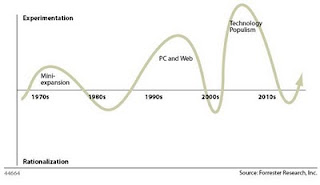
Technology Populism — information workers provisioning technology outside of IT's auspices — is a topic of great interest to both technology vendors and IT departments. But is it more hype than reality? No. Information
workers are increasingly playing a role in selecting and managing the smartphones, computers, and software they use to get their jobs done. And because IT departments feel the necessity of meeting the growing needs of a distributed workforce while cutting costs, we see them increasingly allowing some technology autonomy for workers. For technology product marketers, this means speaking directly to end users about solving their specific business problems. Going forward, technology vendors will have to design, develop, and market products directly to a variety of information workers who, like consumers, have myriad choices
Technology populism is driven by people's need to interact. For many employees, the telephone and e-mail are being replaced by text messaging, instant messaging and mobile devices such as iPhones and Blackberrys, and social computing tools such as Facebook and Wikipedia. Drivers behind technology populism include: (1) Cheap broadband at home and work as personal and professional lives converge (2) A new generation of applications based on network interactions
To compete among the niche group, IT managers to be driven by ‘technology populism'



